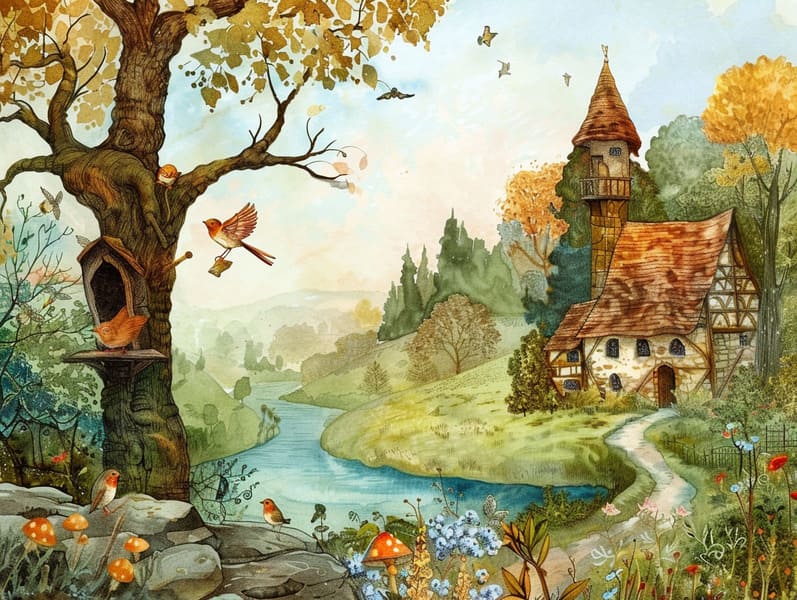The Emergence of Popular Fairy Tales with Its Unchanging Enchantment.
The Emergence of Popular Fairy Tales with Its Unchanging Enchantment.
Blog Article

Popular fairy tales have legendary status. These narratives have been conveyed from one generation to the next millennia before they were ever written down. They came from a variety of cultures, including Indigenous traditions. They were initially transmitted among mature audiences, often carrying themes and messages reflective of the societal norms and beliefs of the time.
Jacob and Wilhelm Grimm, Jacob and Wilhelm (the Grimm brothers), were among the first to collect many of these beloved fairy tales. Their compilation, "Grimm's Fairy Tales," included tales like "Ashenputtel," "Hansel and Gretel," and "Snow-White and Rose-Red," which have since become pillars in the world of famous fairy tales. Similarly, the Danish author's fantastical narratives, such as "The Story of the Little Mermaid," and "The Story of the Ugly Duckling," have gained the love worldwide, cementing their place in the pantheon of treasured fairy tales.
Despite their historical roots, traditional fairy tales remain as relevant as ever, especially as bedtime stories for kids. These charming stories are now available in different formats, including vibrantly illustrated books, fantastical animations, and internet fairy tales.
Their lasting appeal can be connected to several magical reasons:
Important Morals: Traditional fairy tales often present important moral lessons. Fairy tales like "The Tale of the Boy Who Cried Wolf" teach the virtue of being truthful, while "The Race of the Tortoise and the Hare" underline the values of tenacity and humility. These stories offer little ones clear distinctions between truth and falsehood, guiding their moral compass in a subtle yet impactful way.
Kindness and Comprehension: Old fairy tales frequently present personalities facing struggles and tests, fostering children to connect with their struggles and support their triumphs. For instance, "Beauty and the Beast" points out the value of looking deeper to know the true essence of a soul, enhancing understanding and appreciation.
Cultural Appreciation: Many timeless fairy tales are imbued with the cultural contexts from which they originated. Reading these tales can provide captivating looks into different social structures, promoting a sense of world insight and comprehension.
Creativity and Fantasy: The extraordinary elements in traditional fairy tales—enchanted lands—stimulate children’s imaginations. These narratives take readers to extraordinary realms, triggering fantastical thinking and a sense of wonder that continues a lifetime.
Classic fairy tales are not only mesmerizing but also illuminating. They work as entrancing tools in promoting various brain and heart skills in young ones. When ancient fairy tales are read aloud, they enhance speech development by showing new terms and meanings and elaborate sentence structures. This practice also develops hearing perception and attention, as young readers listen intently, expectant to see what happens next.
Furthermore, conversing about the themes and characters of fairy tales can sharpen intellectual skills and reasoning skills. Young ones are instructed to identify patterns, foresee events, and catch on to cause and effect. These explorations also contribute to kids communicate their thoughts and feelings, nurturing their emotional intelligence.
In today’s information age, the availability of digital fairy tales has made these tales more acquirable than ever. Online resources and mobile apps extend ample collections of children's fairy tales that can be enjoyed or listened via anytime, anywhere. Fairy tales told out loud are particularly liked, offering an entertaining method for little ones to savor these bewitching tales. Read-aloud books and read-out-loud stories bring characters and settings to life, often supported by spellbinding check here sound effects and musical scores that intensify the storytelling experience.
The unending appeal of traditional fairy tales lies in their ability to alter to present days while keeping hold of their core messages. Contemporary adaptations of these narratives often incorporate more representative figures and modern settings, making them meaningful to today’s audience. However, the basic principles of courage, empathy, and fair-mindedness remain unchanged, continuing to appeal to kids of all ages.
Old fairy tales also offer a sense of reassurance and comprehensibility. They allow a neat narrative with a transparent beginning, middle, and end, often drawing to a close with the culmination of conflicts and the triumph of goodness over badness. This constancy can be comforting for little ones, proffering a sense of steadfastness in an dynamic world.
Ancient fairy tales continue to enthrall and train new generations, maintaining their appeal and applicability in modern society. As children's night stories, they feature a perfect blend of charm and understanding, nourishing moral values, empathy, and creativity. The availability of online fairy tales and the sought after status of fairy tales read out loud warrant that these traditional fairy tales remain acquirable to new generations.
By holding onto and passing on these stories, we continue to commemorate the rich tapestry of creativity and cultural heritage. Whether you are perusing a colorful picture book, exploring a cyber library, or listening via an audio story, the fascination of Grimm's fairy tales is always within reach. These narratives point out of the endless strength of narratives and its ability to unify us across generations and cultures.
Regardless if you are delving into a vibrantly illustrated book, perusing a online library, or hearing an spoken story, the appeal of children's fairy tales is always within reach.
These narratives emphasize of the perpetual force of stories and its ability to join us across time and space, forming a connection that enchants and educates alike.